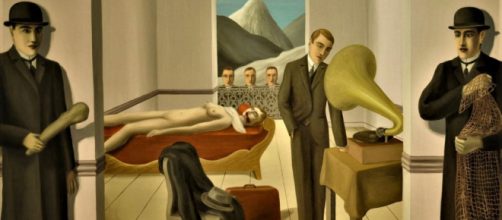If you were a Martian touring earth and caught even a few minutes of U.S. TV commercials hawking health remedies, you’d think Americans were the sickest species in the cosmos.
Now research from the University of Pennsylvania promises relief from a bunch of ills, including anxiety, depression and chronic pain. The remedy? Art museum visits. According to the study, not only do such visits reduce stress, but it also helps the lonely feel more connected.
The happy place?
The question is, will our pill-popping society swallow research labeled “Art Museums as Institutions for Human Flourishing”?
When I think of certain paintings hanging on the walls of American museums, I choke on this research.
I’m thinking of Rene Magritte’s painting “The Menaced Assassin” at the Museum of Modern Art in New York. A nasty crime scene, it measures a whopping 59 1/4″ x 6′ 4 7/8,″ which is hard to avoid.
The vastness of The Menaced Assassin envelopes you and holds you fast, making it hard to escape the terrible story it tells. “Human flourishing” seems like a joke in the face of this work.
Consider Magritte’s picture parts, each meticulously rendered. First, you see a bloodied nude female corpse spread-eagled on a chaise lounge in a room with six men in three-piece suits, bowler hats, and overcoats - one wielding a club.
But there’s something else that disturbs, an air of normalcy, a business-as-usual look that subverts the reality confronting you. Also creepy is the image of one of the men listening to a gramophone. Did the machine record the woman’s screams, and he’s getting off on the playback?
You can’t look away from this painting, so you see more – three additional men looking on from a balcony.
Again, that matter of fact-look to everything in the picture can rile you up.
Wait, there’s more. Through a window, you see a quiet landscape of snow-capped mountains – shades of Alfred Hitchcock whose wide-angle lens routinely showed everyday life going on while a crime is being committed. The contrast emphasizes the randomness of tragic events.
Perhaps the Pennsylvania researchers aren’t familiar with the New York museum’s collection.
But the Philadelphia Museum of Art owns an equally frightful artwork that also puts into question their research.
I’m thinking of Dorothea Tanning’s “Birthday,” a full-length self-portrait showing the artist in a brocaded robe left open to reveal her breasts. But that’s not the disturbing part. That comes slowly into view when you notice that Tanning’s skirt is made of squirming nude bodies.
If that doesn’t upend you, the portrait also shows a tilted floor. And creeping on the floor at the artist’s feet is an ominous prehistoric-looking creature with a long tail and wings.
Michael R. Taylor, a curator at the Pennsylvania museum, included Tanning’s self-portrait in his book, “Masterpieces from the Philadelphia Museum of Art.” You’re left wondering why.
You may also question why anyone would think museum paintings are palliatives. Mind you, I don’t doubt the finding that museums are feel-good places to visit.
Noise abatement
But I don’t think pictures on exhibition have anything to do with that. I think the quiet that you find in museums, is the restorative from a noisy world. They’re like sanctuaries.
Unwittingly making my point, the researcher noted a barrier to their promised outcomes: “Feeling uncomfortable within the art museum or not being able to connect with the art on exhibit.”


